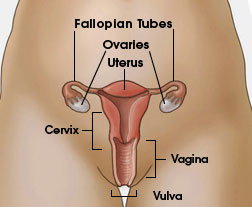Basic Information About Gynecologic Cancers
Five main types of cancer affect a woman's reproductive organs: cervical, ovarian, uterine, vaginal, and vulvar. As a group, they are referred to as gynecologic cancer. (A sixth type of gynecologic cancer is the very rare fallopian tube cancer.)
In 2008 (the most recent year numbers are available)—
- 83,662 women in the United States were diagnosed with a gynecologic cancer.*†
- 27,813 women in the United States died from a gynecologic cancer.*†
*Incidence and death counts cover approximately 100% of the U.S. population.
†Source: U.S. Cancer Statistics Working Group. United States Cancer Statistics: 1999–2008 Incidence and Mortality Web-based Report. Atlanta (GA): Department of Health and Human Services, Centers for Disease Control and Prevention, and National Cancer Institute; 2012. Available at: http://www.cdc.gov/uscs. (full site)
CDC is promoting awareness of gynecologic cancer through its national gynecologic cancer awareness campaign, Inside Knowledge: Get the Facts About Gynecologic Cancer.
What Is Gynecologic Cancer?
Gynecologic cancer is any cancer that starts in a woman's reproductive organs. Cancer is always named for the part of the body where it starts. Gynecologic cancers begin in different places within a woman's pelvis, which is the area below the stomach and in between the hip bones.

- Cervical cancer begins in the cervix, which is the lower, narrow end of the uterus. (The uterus is also called the womb.)
- Ovarian cancer begins in the ovaries, which are located on each side of the uterus.
- Uterine cancer begins in the uterus, the pear-shaped organ in a woman's pelvis where the baby grows when a woman is pregnant.
- Vaginal cancer begins in the vagina, which is the hollow, tube-like channel between the bottom of the uterus and the outside of the body.
- Vulvar cancer begins in the vulva, the outer part of the female genital organs.
Each gynecologic cancer is unique, with different signs and symptoms, different risk factors (things that may increase your chance of getting a disease), and different prevention strategies. All women are at risk for gynecologic cancers, and risk increases with age. When gynecologic cancers are found early, treatment is most effective.
Contact Us:
- Centers for Disease Control and Prevention
Division of Cancer Prevention and Control
4770 Buford Hwy NE
MS K-64
Atlanta, GA 30341 - 800-CDC-INFO
(800-232-4636)
TTY: (888) 232-6348
8am–8pm ET
Monday–Friday
Closed on Holidays - cdcinfo@cdc.gov



